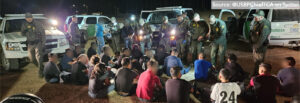Washington, D.C.—Today, a group of senators presented their Bipartisan Framework for Comprehensive Immigration Reform, which calls for a path to citizenship and a further increase in border security measures. The Washington Office on Latin America (WOLA), through its Border Security Project, has done extensive research on the U.S.-Mexico border, including studying the massive security buildup that occurred over the last decade.
“In reality, the border is as safe as it has ever been,” said Maureen Meyer, an expert with WOLA’s Border Security Project. “If we are going to spend more resources on border security, we need to be smarter about where the money is going. We’ve reached a saturation point with the Border Patrol,” said Meyer.
According to WOLA’s recent study Beyond the Border Buildup: Security and Migrants along the U.S.-Mexico Border, the number of migrants apprehended by the U.S. Border Patrol at the southern border has plummeted by 61 percent since 2005 to levels not seen since the 1970s. According to the most recently available information, the average Border Patrol agent apprehends only 20 migrants per year, a 40-year low. (See WOLA’s chart of migrant apprehensions per Border Patrol agent over time.)
“Migration has dropped to levels not seen since the Nixon administration. Any additional resources to the Border Patrol will result in diminishing returns,” said Adam Isacson of WOLA’s Border Security Project.
WOLA also found that there is a serious humanitarian crisis along the border: while migration is down, migrant deaths due to dehydration and exposure are on the rise (see WOLA’s chart illustrating this phenomenon).
At the same time, U.S. ports of entry along the border with Mexico—through which most illegal drugs pass—are seriously under-resourced, with long wait times. “In some sectors, our Border Patrol agents go days without action. Meanwhile, our ports of entry are overwhelmed, tying up legitimate commerce and making it difficult to detect drug trafficking,” said Isacson. “Yet during the years that Border Patrol doubled, staffing at the ports of entry rose by only 15 percent.”
WOLA’s Border Security Project experts recently returned from a trip to the south Texas border; their report is available here. In addition, WOLA’s experts also produce a frequently updated Border Fact Check, which separates rhetoric from reality. For more information about the buildup of the U.S. security presence along the border with Mexico—including the impact of the fivefold increase in the size of the U.S. Border Patrol in the last 20 years, the changing role for U.S. soldiers along the border, and the impact of drones and other high-tech surveillance—see WOLA’s full-length April 2012 report Beyond the Border Buildup.
###
Contact:
Kristel Mucino
WOLA Communications Director
Office: +1 (202) 797-2171
Cell: +1 (617) 584-1713
press@wola.org

